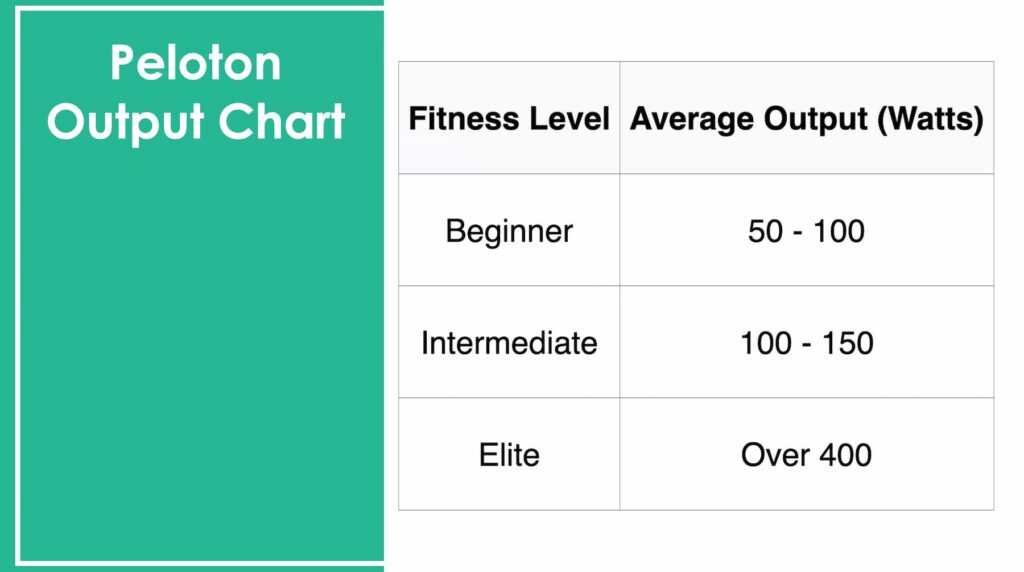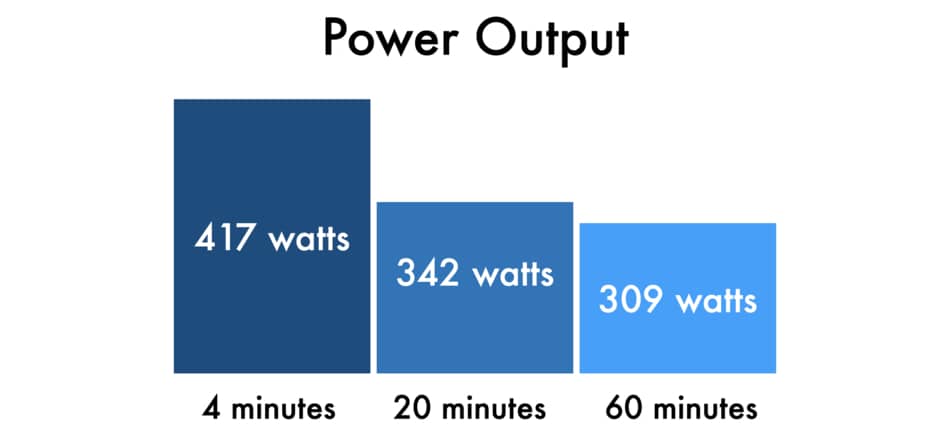When asking what a good average Peloton output is in a 30-minute class, we can refer to a Peloton output chart. It shows that for beginners, a good output might range from 50 to 100 watts, while intermediate riders may aim for 100 to 150 watts. Elite athletes and experienced riders can achieve average outputs exceeding 400 watts.
A Peloton output chart, also known as a Peloton output table, is a graphical representation of the average power output generated during a Peloton bike workout. This chart displays numerical values representing the power output in watts achieved by the cyclist throughout the session, as shown in this diagram.

While using a Peloton output calculator is common, it’s not always accurate due to several influencing factors. These include the rider’s fitness level, body weight, the resistance setting on the Peloton bike, the duration of the workout, and the individual’s effort and intensity during the session.
The main advantages of using a Peloton output chart include tracking progress and monitoring improvements in fitness and strength. However, experiencing discrepancies in output due to calibration issues or software updates is not uncommon. These issues can lead to instances where the Peloton does not display output as expected, leaving some users feeling that their output seems low or inaccurate. To improve Peloton power output, individuals can focus on building muscle size and improving their anaerobic efficiency through targeted training programs.

What is Peloton Output?
Peloton Output refers to the maximum amount of mechanical power generated by an individual during a physical activity on the Peloton bike. Peloton output, measured in watts (W), is the highest sustained level of power exertion that a person can achieve during a Peloton ride and is a crucial indicator of your workout intensity.
Peloton output increases with higher resistance and speed. It is displayed in the bottom middle of the screen, between cadence and resistance. Serving as a real-time indicator of your workout effort, it enables you to track progress, set goals, and optimize your cycling performance. Peloton output reflects your cycling strength and is essential for training analysis for both professional athletes and beginners. Additionally, it is used to calculate Peloton’s strive score, calorie expenditure, and power zones. In the long term, Peloton output plays a crucial role in improving your fitness and achieving your cycling objectives.
What is the average Peloton output for beginners?
Generally, a beginner cyclist may average around 75-100 watts in a 1-hour workout, while a more conditioned rider will exceed 100 watts, and professional cyclists can reach up to 400 watts. For example, Tom Danielson averages 408 watts in his “Spin class.” A Tour de France rider will average 220 to 320 watts during a four-hour stage.
In my 45-minute Peloton classes, I usually average around 120 watts, but that’s only after a good warm-up that involves cycling for 10 minutes, where I gradually increase my pace to achieve a moderate power output of 100 to 140 watts.
What is considered a good Peloton output?
A good Peloton output is subjective but typically falls in the range of 150 to 250 watts. However, this value can vary based on factors such as the type of class you’re taking, class duration, your current fitness level, age, and gender. Additionally, variables like lean body mass, daily recovery, and diet can influence your results.
A solid Peloton output reflects the effort and energy you invest in your workouts. Higher output numbers indicate that your body is adapting to both aerobic and anaerobic demands while enhancing your cycling economy. Cycling economy refers to how efficiently you use energy on the bike. Improved cycling economy means you can generate more watts and sustain higher-intensity rides with less effort and muscle fatigue.
Similarly, what’s considered a “bad” or “low” Peloton output is also subjective and can vary from person to person because what may be considered low for one person could be a significant achievement for another. Rather than focusing on what’s “bad,” it’s more productive to set personal goals based on your current fitness level and work towards improving your Peloton output over time.
how is peloton output calculated?
Peloton output is determined by dividing the total work done in joules (kJ) by the duration of the ride in seconds. For instance, if you complete a 20-minute ride and achieve 150 kJ (150,000 joules) of work during that time, you would divide 150,000 joules by 1,200 seconds (20 minutes converted to seconds). This calculation results in an average power output of 125 watts for your 20-minute Peloton ride.
Use this Peloton power output calculator below.
Peloton Power Output Calculator
What factors affect Peloton output in a home gym environment?
Factors affecting your Peloton’s output in a home gym environment are listed below.
- Class Intensity: More strenuous Peloton rides require higher resistance and cadence, leading to higher outputs.
- Training History: Training history significantly impacts Peloton power output due to differences in metabolic clearance rates. A study by Messonnier et al. (2013) from the University of California Berkeley found that trained individuals had a metabolic clearance rate (MCR) 97% higher than untrained individuals during high-intensity rides. This higher MCR, which reflects the body’s efficiency in removing substances like lactic acid from the blood, enables trained riders to sustain higher output levels for longer periods.
- Gender: Gender differences in Peloton output are largely attributed to variations in muscle fiber composition between men and women. A study by Gordon R Chalmers in 2011 from Western Washington University revealed that men typically have larger type IIA muscle fibers, known for their low oxidative capacity and large size. Conversely, women generally possess a higher distribution of type I fibers, explaining the lower power output values.
- Age: Age-related decline in strength and Peloton output is significantly influenced by the loss of muscle mass, particularly the reduction in fast-twitch (type II) muscle fibers. A study conducted by J Lexell and colleagues in 1988 at the University of Umeå, Sweden, found that type II fiber area can decrease by 20 to 50% with age. This significant reduction in fast-twitch fibers, which are crucial for high-intensity efforts, leads to a decrease in overall strength and power output in older individuals, while the size of type I (slow-twitch) fibers is less affected by aging.
- Riding Position: The riding position, particularly standing versus seated, significantly affects power output in Peloton. Research by Stefan Vogt at the University of Freiburg demonstrated this effect during the Giro d’Italia. His 2007 study found that, on average, standing positions generated higher power outputs (367 watts) compared to seated positions during flat rides (239 watts). This indicates that adopting a standing position, especially during acceleration, hill climbing, or sprinting, can lead to considerably higher power outputs in cycling.
- Time of Day: The time of day can significantly impact Peloton output due to variations in muscle temperature. A study by N. Souissi et al. in 2004 found that muscle temperature, and consequently power output, is typically higher in the afternoon (between 4:00 pm and 6:00 pm) than in the morning. This study, conducted at the Université de Basse-Normandie, revealed that power output could be about 8% higher in the afternoon, indicating that the optimal time for achieving higher power outputs might be later in the day when muscles are warmer.
- Body Composition: A rider’s ratio of muscle to fat can influence power output, as more muscle mass typically equates to greater strength and higher output.
- Nutrition and Hydration: Adequate nutrition and hydration significantly impact performance, with proper fueling and hydration enhancing endurance and output levels.
- Body Weight: Heavier riders might produce higher absolute power output due to greater muscle mass, but when adjusted for weight (watts per kilogram), lighter riders often have an advantage, especially on climbs.
What is a Good Peloton Output For 20 Minutes?
A good Peloton average output for a 20-minute session typically falls in the range of 100 to 180 watts, but this can vary depending on the class type. Classes with higher intensity like HIIT and Power Zone Max rides often require greater resistance and cadence to achieve this range. Conversely, if you’re participating in less intense 20-minute rides, such as recovery rides, or low-impact sessions, or if you’re a beginner, your output may be notably lower than the mentioned range.

In terms of total output, a good Peloton total output for a 20-minute ride typically ranges from 200 to 330 kilojoules (kJ). To enhance your kJ and total output on the Peloton, you should focus on increasing the intensity of your classes and consider opting for longer sessions.
What is a Good Peloton Output For 30 Minutes?
A good Peloton output for a 30-minute ride typically falls in the range of 100 to 150 watts, depending on the ride’s intensity. In terms of total output, aiming for 300 kJ to 500 kJ is a reasonable goal for a 30-minute session, with Tabata rides being a great choice for achieving higher output due to their 2:1 work-to-rest ratio, demanding a significant effort.

World-class cyclists may target an output range of 300 to 400 watts for a 30-minute class, while the all-time highest Peloton outputs, exceeding 2000 kJ, should be approached with caution as they may result from calibration discrepancies.
What is a Good Peloton Output For 45 Minutes?
A good Peloton output for a 45-minute class typically falls in the range of 80 to 150 watts, with a recommended total output ranging from 400 kJ to 650 kJ. To achieve higher output in 45-minute classes, consider taking climb rides, interval rides, or power zone rides.

These classes provide a balanced blend of endurance and HIIT training, enhancing aerobic capacity and VO2 max. While aiming for high output, keep in mind that elite athletes may sustain levels around 300 to 350 watts, with exceptional cases like British cyclist Christopher Clive Froome maintaining over 400 watts for just over 41 minutes.
Why is good power output important?
Good peloton power output is crucial as it not only serves as a strong predictor of athletic ability but also plays a critical role in ensuring longevity, enhancing performance, improving mobility, and promoting overall health.
The duration of your peloton class significantly impacts your power output. Shorter rides often allow for the maintenance of higher power output levels compared to longer 90-minute sessions. For example, my personal record for average power output in a 20-minute class stands at 244 watts, whereas it drops to 202 watts in a 60-minute class.
A 2019 study by Martin J MacInnis published in the International Journal of Sports Physiology and Performance indicates that trained cyclists can typically maintain an average of 417 watts in a 4-minute ride, 342 watts in a 20-minute ride, and 309 watts in a 60-minute ride, as shown in this diagram.

Please note that these numbers are reflective of experienced cyclists and may differ from what you see on the Peloton leaderboard. In shorter rides, a good peloton output typically falls within the range of 220 to 270 watts, depending on the class type and workout protocol. High-intensity interval training classes often demand higher output levels due to their increased intensity.
What is the difference between Peloton Average Output and Total Output?
The difference between Peloton’s Average Output and Total Output lies in their measurement units and calculation. Peloton Average Output is expressed in watts and represents your power output averaged over the duration of your ride, often indicating your effort level.
On the other hand, the Peloton Total Output is measured in kilojoules (kJ) and quantifies the total energy expended during your ride. To calculate Total Output, you sum up the Average Output for the entire ride, multiply it by the duration in seconds, and then divide by 1000 to convert it to kJ.
how to improve peloton output?
To boost your Peloton output and enhance performance, you should maintain a consistent training routine for gradual fitness improvement, incorporate progressive resistance, interval training, and proper bike setup calibration to optimize your workouts and power output.
how To calibrate the peloton bike for higher output?
Calibrating your Peloton bike is crucial for accurate performance tracking. To perform Peloton calibration effectively, ensure your bike is set correctly, maintain consistent environmental conditions, and periodically recalibrate your to keep your output data precise.
What to do when output not working on the peloton?
If your Peloton’s output isn’t working, first check your internet connection and make sure it’s strong, then restart your Peloton by unplugging it for 30 seconds and plugging it back in. If the issue persists, contact Peloton support for further assistance, as it might be a hardware problem.
Is Peloton output a reliable metric for home fitness goals?
Yes, Peloton output is a reliable metric for home fitness, providing a quantifiable measure of your workout intensity and endurance.
does weight affect peloton output?
Yes, Peloton output and weight go hand in hand; a heavier rider might generate higher output due to more mass to propel, but this doesn’t necessarily equate to better fitness.
